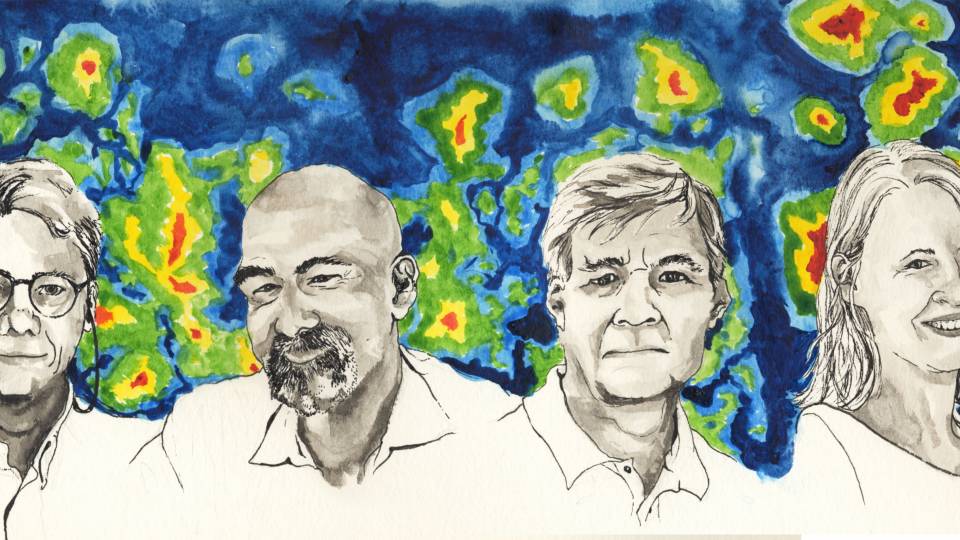After nine years of scanning the sky, the Wilkinson Microwave Anisotropy Probe (WMAP) space mission has concluded its observations of the cosmic microwave background, the oldest light in the universe. The spacecraft not only has given scientists their best look at this remnant glow, but also firmly established the scientific model that describes the history and structure of the universe.
"The end of WMAP is a moment of sadness, joy and satisfaction," said David Spergel, chair of Princeton's Department of Astrophysical Sciences and one of the key scientists on the project. "Sadness -- thinking about its journey come to an end. Joy -- from thinking about the pleasure of working with my colleagues on the WMAP team. And satisfaction -- thinking about its successful nine-year run."
WMAP was designed to provide a more detailed look at subtle temperature differences in the cosmic microwave background that were first detected in 1992 by NASA's Cosmic Background Explorer. The WMAP team has answered many longstanding questions about the universe's age and composition. WMAP acquired its final scientific data on Aug. 20. On Sept. 8, the satellite fired its thrusters, left its working orbit and entered into a permanent parking orbit around the sun, completing its mission as planned.
"WMAP has opened a window into the earliest universe that we could scarcely imagine a generation ago," said Gary Hinshaw, an astrophysicist at NASA's Goddard Space Flight Center in Greenbelt, Md., who manages the mission. "The team is still busy analyzing the complete nine-year set of data, which the scientific community eagerly awaits."
WMAP's work involved detecting a signal that is the remnant afterglow of the hot young universe, a pattern frozen in place when the cosmos was only 380,000 years old. As the universe expanded over the next 13 billion years, this light lost energy and stretched into increasingly longer wavelengths. Today, it is detectable as microwaves.
"We launched this mission in 2001, accomplished far more than our initial science objectives, and now the time has come for a responsible conclusion to the satellite's operations," said Charles Bennett, WMAP's principal investigator at Johns Hopkins University in Baltimore.
The experimental program to measure the cosmic microwave background radiation -- the remnants of the Big Bang -- began at Princeton more than a decade ago and involved a team of University contributors, including Princeton University cosmologist David Wilkinson and the late physicist Robert Dicke, as well as Spergel, Lyman Page, a physics professor, and Norm Jarosik, a senior research physicist. First known as MAP, the spacecraft later was renamed WMAP to honor Wilkinson, who died in September 2002. The WMAP team was able to glean much from the experiment.
The mission established that the cosmos is 13.75 billion years old, with a degree of error of one percent. WMAP is in the Guinness Book of World Records for "most accurate measure of the age of the universe."
WMAP also showed that normal atoms make up only 4.6 percent of today's cosmos, and it verified that most of the universe consists of two entities scientists don't yet understand: Dark matter, which makes up 23 percent of the universe, is one of the entities, and is a material that has yet to be detected in the laboratory; and dark energy is a gravitationally repulsive entity that may be a feature of the vacuum itself. WMAP confirmed its existence and determined that it fills 72 percent of the cosmos.
Another important WMAP breakthrough involves a hypothesized cosmic "growth spurt" called inflation. For decades, cosmologists have suggested that the universe went through an extremely rapid growth phase within the first trillionth of a second it existed. WMAP's observations support the notion that inflation did occur, and its detailed measurements now rule out several well-studied inflation scenarios while providing new support for others.
WMAP was the first spacecraft to use the gravitational balance point known as Earth-Sun L2 as its observing station. The location is about 930,000 miles away.
"WMAP gave definitive measurements of the fundamental parameters of the universe," said Jaya Bapayee, WMAP program executive at NASA headquarters in Washington, D.C. "Scientists will use this information for years to come in their quest to better understand the universe."
In May, Spergel, the Charles A. Young Professor of Astronomy on the Class of 1897 Foundation, and Page, the Henry DeWolf Smyth Professor of Physics, were recognized, along with their longtime collaborator Bennett, with the Shaw Prize for their leadership of WMAP by the Hong Kong-based Shaw Prize Foundation.
